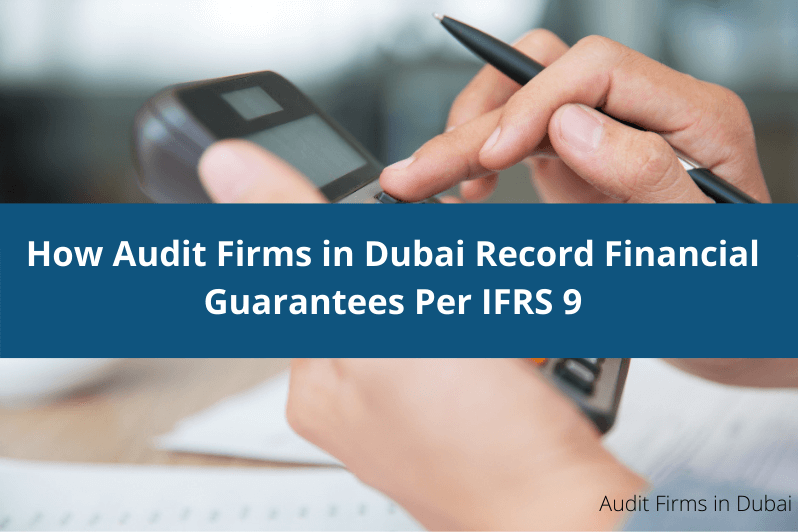A financial guarantee is a distinctive form of financial liability recognized in IFRS 9. Audit firms in Dubai, on behalf of a company, when the said company backs up debt or loan that another UAE entity has taken. It usually happens among firms within a single group. Generally, because it is an intra-group, there isn't any premium that the debtor pays to the party providing the guarantee.
Financial Guarantee as Defined by IFRS 9
According to IFRS 9 Financial Instruments, the financial guarantee is an agreement that demands the issuer to remit a certain amount of money to reimburse the holder for a loss incurred. The said debtor fails to make payments accordingly, based on the terms of a debt instrument.
So, there is an issued financial guarantee contract because the parent Dubai entity agreed to reimburse the lending bank if a subsidiary defaults in payment. And of course, the company audit specialists are correct, and they have to record this guarantee.
Before explaining how financial audit experts account for financial guarantees, let's first understand the general guarantee to support subsidiaries suppose there is negative equity. This is not recognized as a financial guarantee in IFRS 9 since it is not specific, and there are no special payments. Also, this guarantee type covers nearly anything on debts.
Typically, it would help to record an issued financial guarantee at fair value. That's the most fundamental measurement rule in IFRS 9. The fair value of such a guarantee also depends on various factors, as we shall discuss later.
Typically, companies in Dubai, UAE issue financial guarantees to third parties, not intragroup. Their audit services team records premium charges for the guarantee. In this context, some charges for the guarantee are considered fair value. Technically, the guarantee companies issue intragroup a no fee.
As such, internal auditors or, in the case of an external auditor, some alternative approaches must be applied as per IFRS 13 Fair value measurement. For instance, an audit specialist can calculate the benefit for the debtor due to the guarantee.
Read also : How Audit Firms in Dubai handle capex threshold policy
How much interest does the Debtor Pay Guarantee?
Suppose the debtor pays 10% with the guarantee while the interest rate on the market for unguaranteed loans is 11%. In that case, the fair value of the guarantee is the present value of the different interests due on unguaranteed and guarantee loans.
Understanding Journal Entries in This Context
For example, assuming a Dubai, UAE company receives a premium of AED 1000 for issuing a financial guarantee for a 5-year loan. Then the journal entry would be:
- Debit Cash: AED 1000
- Credit liabilities from financial guarantees: AED 1000
If the company does not receive any premium, then they:
- Debit Profit/Loss: the fair value of the company's guarantee.
- Credit liabilities from financial guarantees: the fair value of the company's guarantee.
- Financial guarantees: subsequent measurement
Firstly, company audit professionals should amortize the financial guarantee of a company in question according to IFRS 15 Revenue from Contracts with Customers. Most of the time, this is done straight-line throughout the loan.
Next, IFRS 9 standard indicates that financial guarantees should be measured according to the higher of the following:
- The loss allowance is often calculated as expected credit loss based on IFRS 9 standards.
- This is the figure that is originally recorded as fair value minus any amortization or accrued revenue.
Here, the major challenge is to determine how much credit loss your subsidiary is likely to incur.
As a result, you must:
Identify the stage of your subsidiary's loan - stages 1, 2, 3.
According to the stage of the loan, calculate the expected loss allowance as a 12-month expected loss or as a lifetime expected loss.
To calculate the carrying amount of your financial guarantee, compare the amount of the expected credit loss with the fair value of the original financial guarantee less any amortization.
The carrying amount is fine if the ECL is less than the ECL.
The revaluation of the financial guarantee must be recorded in profit or loss if the ECL is higher than the carrying amount.
Continuity Of Financial Guarantees Illustrated:
Regarding the loan guarantee of AED 1000 over five years, let's do a recap.
The entry on the balance sheet would be amortized straight-line over five years (to simplify).
Credit obligations:
- AED 200 (1 000/5)
Credit Profit or loss
- Income from financial guarantees: AED 200.
To determine the expected credit loss, you need to determine the size of the loan you are backing up.
Because of the larger financial guarantee, the carrying amount is AED 800, while the ECL is AED 500. Therefore, you keep the financial guarantee at AED 800.
If it’s AED1200 for instance, then the difference of 400 (1200% of ECL deduct 800%) should be accounted for as profit or loss.
You may also like : View of IAS 10 events after reporting period
Get Professional Audit Services Assistance from The Best Auditors in Dubai, UAE
Are you looking for reliable audit services for your company in Dubai? Try Audit firms in Dubai, renowned from providing world class auditing services for local and international companies.
Umapathy Anuruthan, is a Senior Auditor at the firm, holds a Business Management Degree and carries with him an experience of 6+ Years, having worked in two of the Big 4 audit firms. He has a ‘hands-on’ understanding of external audits and financial reporting and is well-known for his approach to ensuring the highest quality and accuracy in audits for clients of numerous industries.
